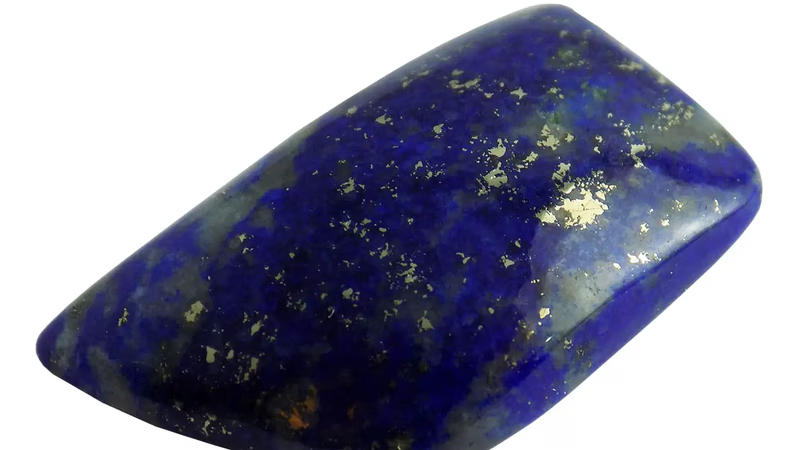
Lapis lazuli: A symbol of power and beauty in trade.
Lapis lazuli has been referenced in ancient Mesopotamian texts, such as the Epic of Gilgamesh, one of the oldest known literary works. The blue stone was associated with royalty and divinity, symbolizing power, protection, and wisdom. Lapis lazuli held great value in ancient Egyptian civilization. It was considered a precious stone and was highly favored for jewelry and decorative objects. The Egyptians associated Lapis lazuli with the heavens and used it to depict the night sky in their artwork. The stone was also believed to have protective and healing properties.
While Lapis lazuli is not specifically mentioned in the Qur'an, it is referenced indirectly in descriptions of Paradise (Jannah). In Islamic literature and hadith (sayings and actions of Prophet Muhammad), descriptions of the splendor and beauty of Paradise often include references to precious gemstones, including Lapis lazuli. These descriptions highlight the magnificence and rewards that await the righteous in the afterlife.
Azure has been widely used in Islamic art and architecture. It can be found in intricate calligraphy, manuscript illumination, mosaics, and tile work in mosques, palaces, and other Islamic structures. The vibrant blue color of Lapis lazuli adds a sense of richness and elegance to these artistic creations, symbolizing the divine and spiritual realms.
Lapis lazuli is mentioned in Islamic literature and holds significance in Islamic traditions. In the Islamic tradition, Lapis lazuli is referred to as "Yaqut," and it is associated with various symbolic meanings. It is believed to represent truth, sincerity, and the heavens. The stone is also mentioned in the description of Paradise (Jannah), where it is said to be used in the construction of palaces and structures for the righteous.
Azure is mentioned in historical texts, including travelogues and accounts of explorers and merchants. For instance, the famous Moroccan scholar and traveler Ibn Battuta, who extensively documented his travels across the Islamic world in the 14th century, mentioned Lapis lazuli in his writings. He described seeing Lapis lazuli being used in architecture and decorative arts during his visits to various regions.
Scientists have so far identified several mines for lapis lazuli, but only a few by lithological experiments approved. Abu Rihan al-Biruni writes in the valuable book Al-Jamahir Fi Al-Ma'rifah Al-Jawahir: He also says: « Azure is called Arminaton in Rome». This book is the oldest work that mentions the existence of Lajevardi mine other than Badakhshan mine. In the book of geography related to the sixth century AH. AH, Only the existence of lapis lazuli mine in the mountains of " Sabar Maq " in Khorasan is mentioned.
While the science of archeology and geology of the two mines of Badakhshan (in the fourth and third millennia BC and Quetta are called, Islamic texts associated with Azure mine in northwest Iran was confirmed. In the eighth century, Ibn Battuta and Amoli only mentioned the Lapis Lazuli mine in Badakhshan. In the same century, in the book of Iraq Al-Jawahir in Al-Nafis Al-Atayb, for the first time, four types of azure, Badakhshan, Kermani, Georgian, and Desmari are mentioned.
Glazed brick panel with Aurochs - details of the Babylonian Ishtar Tor (Ishtar Gate) in the Istanbul Archeology Museum on October 30, 2015, in Istanbul, Turkey. In the tenth century, which includes the last period of writing this article, Bayhaqi and Mohammad Ibn Mansour mentioned four mines in the Kashani style in mentioning the azure mines. With the difference that instead of the Georgian mine, they call it the Karaji mine. Beyhaqi states this in determining the location of Karaj.
Lapis lazuli has been associated with various metaphysical properties in Islamic traditions and other belief systems. It is believed to have healing properties and is considered beneficial for mental clarity, spiritual growth, and protection against negative energies. Some Islamic scholars and practitioners of traditional medicine have recommended the use of Lapis lazuli for its potential therapeutic benefits.
Azure has been a valuable commodity in the ancient world, and its trade routes and networks played an important role in connecting different civilizations. In Islamic history, merchants and explorers traveling along the Silk Road and other trade routes would encounter Lapis lazuli as it was traded between different regions, including Afghanistan, Iran, Central Asia, and the Mediterranean. Its significance in trade and commerce contributed to its cultural importance.
Lapis lazuli carries symbolic meanings in Islamic culture. It is associated with virtues such as integrity, sincerity, and truthfulness. The stone's deep blue color is often seen as a representation of the heavens and the eternal truths of Islam. It has been used as a symbol of spiritual enlightenment and a reminder of the divine.
-
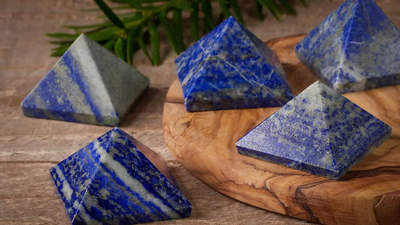
Lapis lazuli is a significant stone in chakra therapy, particularly for the throat chakra, which governs communication and self-expression. It enhances verbal and written communication skills, promotes clarity, and helps overcome shyness and public speaking fears. When used in meditation or energy healing, placing Lapis lazuli near the throat chakra is believed to clear blockages and balance energy. The stone also harmonizes masculine and feminine energies, supporting overall well-being and spiritual growth. Additionally, Lapis lazuli aids in accessing inner wisdom and enhances intuitive awareness. Historically valued by ancient Egyptians, it symbolizes truthfulness and integrity, encouraging authenticity in one"s actions. The stone promotes emotional healing by calming the mind and alleviating anxiety while facilitating deep relaxation. It is also linked to the third eye chakra, enhancing intuition and spiritual vision.
Furthermore, Lapis lazuli assists individuals in understanding their true selves, releasing repressed emotions, and providing spiritual protection against negative energies. Overall, it serves as a powerful tool for self-discovery and connection to higher realms. "
-
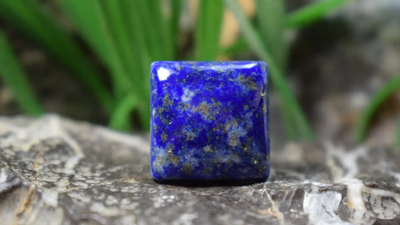
Identifying genuine Lapis lazuli from synthetic alternatives requires careful examination of various characteristics. Natural Lapis lazuli is typically deep blue with unique variations, including golden or white calcite streaks and specks of pyrite. In contrast, synthetic stones often exhibit a uniform, overly vibrant color that lacks the natural imperfections found in authentic specimens. Price can also be a telltale sign; if a Lapis lazuli stone is significantly cheaper than market value or available in large quantities, it may be synthetic. Techniques for verification include using a Chelsea Filter, which reveals different light reflections between natural and synthetic stones. Additionally, physical tests such as checking for an unpleasant odor when heated or observing color differences in cracks can help distinguish authenticity. Natural stones usually contain inclusions and irregular patterns, while synthetics tend to have a consistent appearance. For definitive identification, consulting with a qualified gemologist or reputable laboratory is recommended to ensure the authenticity of the stone.
-

Lapis lazuli"s value is primarily determined by its color, with the most sought-after stones showcasing a deep, vivid blue hue. Inclusions of minerals like pyrite and calcite can enhance the stone"s beauty, but excessive inclusions may detract from its clarity. The size and shape of Lapis lazuli vary based on their intended use, with larger stones favored for statement pieces and smaller ones for intricate designs. A high-quality polish is essential for maximizing visual appeal, as it enhances the stone"s color and shine. The origin of the stone also plays a significant role in its quality; Afghan Lapis lazuli is historically esteemed for its rich blue color and high pyrite content, while stones from Chile and Russia offer unique characteristics. Authenticity is crucial when purchasing Lapis lazuli, as synthetic alternatives exist. Buyers should seek reputable sources to ensure they acquire genuine stones without treatments that alter their natural appearance. While not rare, high-quality Lapis lazuli with exceptional features can be scarce, making them valuable to collectors.
Ultimately, the best type of Lapis lazuli depends on personal preferences regarding color intensity and inclusion patterns. "
-
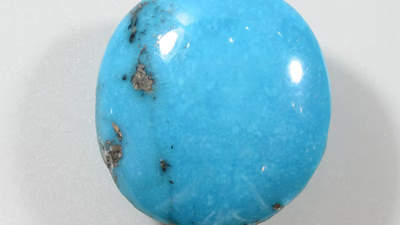
Synthetic Lapis lazuli, or synthetic Azure, is a man-made alternative to natural Lapis lazuli gemstones. Created in laboratories, it mimics the appearance of natural stones using various minerals and binding agents. Commonly, powdered minerals like lazurite and pyrite are combined with resins to produce synthetic stones. While these synthetic versions are more affordable and widely available, they lack the authenticity and inherent value of natural Lapis lazuli. Buyers should be cautious and knowledgeable about distinguishing between the two types when purchasing. Natural Lapis lazuli is a metamorphic rock valued for its unique color and historical significance, often used in jewelry and art. In contrast, synthetic stones may fade over time depending on the quality of materials used in their production. Various other stones can be confused with natural azure due to similar appearances, including sodalite and azurite.
The market also features different names for synthetic products that can mislead consumers. Understanding these differences is crucial for making informed purchasing decisions.
-
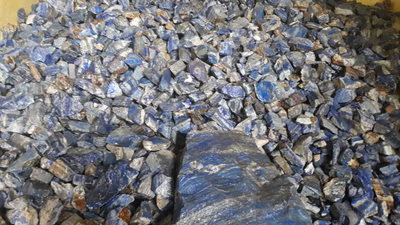
Lapis lazuli, or azure, is a semi-precious gemstone renowned for its vibrant blue hue and historical significance. Composed mainly of lazurite, calcite, and pyrite, its color can range from light to dark shades, often featuring golden flecks or white streaks. Historically sourced from Afghanistan"s Sar-e-Sang mines, it is also found in Russia, Chile, Canada, and the U. S. Lapis lazuli has a moderate hardness of 5 to 6 on the Mohs scale, making it suitable for jewelry and decorative items. Its cultural importance spans thousands of years; ancient civilizations like the Egyptians and Greeks valued it for its protective properties and associations with wisdom and enlightenment. The stone is used in various forms including beads, pendants, sculptures, and as a pigment for ultramarine in art. Lapis lazuli"s unique characteristics include its opaque nature and glassy to waxy luster.
It has been utilized not only for aesthetic purposes but also in dyeing fabrics and pottery. The gemstone"s rich history reflects its enduring appeal across cultures. "
-
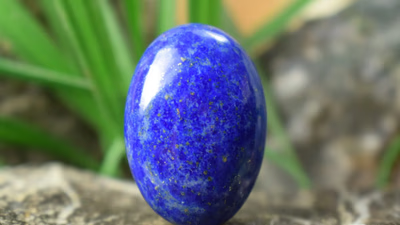
Lapis lazuli, a highly valued gemstone, has been mined for thousands of years in West Asia, particularly in Afghanistan and Iran. The geological conditions in this region are ideal for the formation of Lapis lazuli deposits, which are primarily found in metamorphic rocks. The Sar-e-Sang mine in Afghanistan is one of the oldest and most renowned sources, with a history dating back over 6,000 years. Other notable sources include the Andean region of Chile and Lake Baikal in Russia. The craftsmanship and mining traditions passed down through generations have established West Asia as a leading producer of high-quality Lapis lazuli. Despite the abundance of resources, demand often exceeds supply, leading to the use of synthetic alternatives. The cultural significance of Lapis lazuli is profound; it has been utilized in jewelry and religious artifacts throughout history. As global interest continues to rise, maintaining these mines is crucial for sustaining both local economies and international trade.
-

Lapis lazuli has been revered since ancient times for its medicinal and magical properties. In ancient Egypt, it was ground into powder for use in ointments and cosmetics, believed to cure eye ailments and protect against evil spirits. Greek physician Dioscorides noted its cooling effects and therapeutic benefits for fevers, inflammation, and skin diseases. Historical texts from scholars like Ibn Sina highlight its medicinal uses, including treatment for digestive issues and as an antidote for poison. Lapis lazuli was also recognized in Traditional Chinese Medicine (TCM) for its benefits to the liver, spleen, and respiratory system, promoting mental clarity and spiritual well-being. Its applications extended to Islamic medicine where it was used to treat fevers and enhance cognitive functions. Despite the lack of archaeological evidence regarding its trade specifically for medical purposes, ancient writings provide substantial insights into the healing properties attributed to this azure stone.
-

Lapis lazuli, a blue stone with historical significance, has been referenced in ancient texts, including the Epic of Gilgamesh and Islamic literature. In ancient Mesopotamia and Egypt, it symbolized power and divinity, often used in jewelry and art. Although not explicitly mentioned in the Qur"an, it is associated with Paradise in Islamic tradition. The stone"s vibrant azure color has adorned Islamic art and architecture, representing spiritual realms. Historical accounts by travelers like Ibn Battuta highlight its use in decorative arts across various regions. Lapis lazuli was traded along significant routes such as the Silk Road, connecting civilizations from Afghanistan to the Mediterranean. Its metaphysical properties are recognized in Islamic traditions, believed to promote mental clarity and protection against negativity. The trade of Lapis lazuli not only reflects its economic value but also its cultural importance across different societies.








